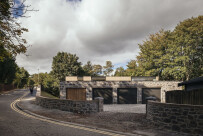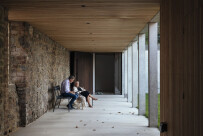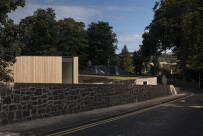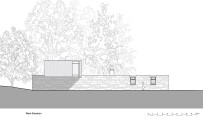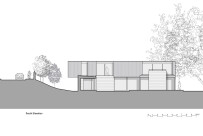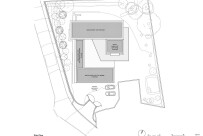The Arbor House is a contemporary family home located to the west of the Scottish city of Aberdeen. Built in a conservation area, it was designed by Aberdeenshire-based architectural studio Brown & Brown. The two-story residence is constructed primarily of a timber frame and finished with a mix of board-marked concrete, larch cladding, and stone walls retained from the existing site.
The meticulous design of The Arbor House is evocative of Californian modernism: A contemporary, cantilevered home, it is situated in harmony with the surrounding landscape, and blurs the boundaries between indoor and outdoor spaces. Moreover, its design places a strong emphasis on craftsmanship and carefully chosen construction materials. In line with Brown & Brown’s approach to sustainable architecture, The Arbor House is a low energy building. By capitalizing on the use of natural materials, heating, and ventilation, its objective is to reduce operational costs and carbon emissions.
Salvaged materials
The Arbor House replaces a dilapidated stone cottage, most of which was carefully deconstructed, but the process was a challenging one. Andrew Brown, co-founder of Brown & Brown, explains: “As the house sits within a conservation area, it can be difficult to achieve planning permission for buildings with a contemporary design. However, we worked with a supportive planning department that helped overcome some concerns raised by a local conservation body.”
Masonry from the old stone structure was salvaged and reused to craft a low, sweeping boundary wall at street level. Brown adds: “We wanted to design a house that made use of the stone skin of the original building in order to create a private garden.” To achieve this, one wall of the stone cottage remains in situ, forming part of a colonnade that is lit by original window openings. This cloistered entry is described as offering a “mental airlock” and marks a clear separation between the road and the enclosed gardens and home. The unaltered apertures in the stone wall “offer small glimpses into the cloister and courtyard, adding layers and intrigue to the home,” says Brown.
Designing The Arbor House
To capture and harness the warm southern sunlight, The Arbor House sits beyond a gentle slope on the site’s northern corner. Adjacent to a busy road, this position also masks the home’s volume. Brown & Brown designed The Arbor House as four connected structures around a central courtyard/garden. The home comprises a one-story garage, a colonnade, and a two-story residence with an adjoining one-story block.
Describing the building’s materials, Brown notes: “those used on the ground floor are a mix of reclaimed and retained stone and board-marked concrete. They work to achieve a feeling of solidity around the garden, and provide a contrast with the lighter volume of timber and glass above.” The board-marked surface of the concrete creates an especially pleasing and decorative effect. Brown adds: “For the upper level, we wanted a material that was visually lighter than those used on the ground floor. Larch cladding provides a contrast to the concrete and stone and will weather over time, helping to embed the house in the site.”
Energy performance and operational carbon
Standard Assessment Procedure methodology was used to calculate the energy performance of The Arbor House. (This is a UK government recommended system for measuring the energy rating of residential dwellings.) As a structure, The Arbor House is thoroughly insulated, resulting in low heating demands. “The building is heated via a ground source heat pump that provides renewable heating; there is also a MVHR (Mechanical Ventilation Heat Recovery) system that helps with air circulation,” says Brown. These initiatives act to minimize the home’s operational energy costs and carbon emissions.
The Arbor House does not use any fossil fuel energy and takes advantage of low carbon electricity; a wood burner is also installed. The home’s operational carbon performance, associated with regulated energy, is measured at 3.20 kgCO2/yr/m2. The U-value performance (the measure of the overall rate of heat transfer) is calculated at 0.37 W/m2K. This figure is a combined average for walls, floors, roofs, windows, and doors, and is significantly lower than the baseline U-values set out in the Scottish government’s “Building standards technical handbook 2020” for domestic properties.
Embodied carbon
The embodied carbon of The Arbor House is measured at 376.4 kg CO2 eq/m2. This figure accounts for the impact of carbon associated with construction materials, transport of these materials to the site, and the construction itself. In the UK, the suggested embodied carbon benchmark for newly built properties — constructed in the 2020s — is 500 kg CO2 eq/m2 (a figure determined by a voluntary network of built environment professionals known as LETI — “Low Energy Transformation Initiative”). The Arbor House therefore easily achieves this benchmark.
The main contributing factor to the embodied carbon figure is the home’s larger volume of PIR insulation — containing polyurethane in the form of a rigid foam, PIR is manufactured under high temperatures and uses a greater amount of energy (largely derived from fossil fuels). The next biggest contributor to the home’s overall embodied carbon is the use of metal: structural I-beams and rebar in the foundations are made with steel; the window frames are made with aluminum. It is therefore the home’s sizable use of sustainably sourced timber that substantially reduces the level of embodied carbon.
Glazing and roofing
The Arbor House is an especially bright and airy residence, its extensive use of glazing ensuring an abundance of naturally lit spaces. The glazing draws in and stores sunlight in the thermal mass; during the summer months, it opens to passively cool the house. “We fitted 'HiFinity' units by Reynaers and the glass used is double-glazed,” says Brown. “Calculations showed that windows with triple glazing would increase the chances of the house overheating, due to the thermal performance of the rest of the building envelope.”
The design of The Arbor House also includes the use of green roofs, an option that Brown encourages where appropriate. “Green roofs are very effective at providing attenuation during times of high rainfall, lessening the strain on the public drainage infrastructure,” he says. “They are also excellent for biodiversity. For example, a green roof creates a microclimate for birds and beneficial insects. It also reduces internal temperature in summer and insulates in winter.” Furthermore, the green roofs on The Arbor House blend harmoniously with the surrounding trees.
Interior design
The floor plan of The Arbor House is logically designed to enable any necessary adaptations as the clients grow older. Entering the house via the colonnade, a wide hallway, with uninterrupted views to the garden, leads to a double-height glazed atrium. Here, the home’s connection with nature is clearly evident, while a sculptural birch plywood spiral staircase is a standout feature. “The staircase sits within a space that has an orthogonal layout,” says Brown. “We therefore wanted a design with an obvious organic form — a smooth, sinuous parabolic curve.” The staircase was created by the architect in collaboration with Angus+Mack, a local artisanal woodworking studio. Brown adds: “There are examples of excellent craftsmanship throughout the house, including the custom fumed oak pivot front door and a timber board-marked concrete fireplace [in the lounge].”
The lounge extends into the garden — flanking the internal courtyard, this space is glazed end-to-end and floor-to-ceiling. The second floor of The Arbor House hosts the main bedroom and guest quarters. “It is our aim to design and build a house with liveable spaces, both inside and outside,” says Brown. “In The Arbor House, the spaces connect to the garden, an area that is private by virtue of the retained stone wall and new colonnade. The result is the creation of a secret retreat, a sheltered and intimate dwelling.”
Slender larch battens have also been used internally and create an aesthetic ceiling; in conjunction with the external cladding, this ensures a consistent design language throughout the house.
In the design of The Arbor House, Brown & Brown ensure the architecture respects its setting, and strive to accomplish this by using a restrained palette of salvaged, local, and natural materials. As a practice, the studio understands that choice of materials, their transportation to the site, transparency of the supply chain, and decisions around how to heat a home, will have a collective consequence on the environmental sustainability of a project. In what can be described as a hybrid approach to construction, The Arbor House cleverly combines conventional, low-emission, and bio-based building materials, achieving an effective reduction in embodied and operational carbon.
Project details
On-site start date: February 2019
Completion date: July 2022
Internal floor area: 273.5m2
Terraces: 174m2
Garage and store: 70m2




































